The constant big-budget movie releases with their A-list stars, state of the art technology, and expensive advertising campaigns can make it easy to forget that most of the movie industry just doesn’t have that kind of money. Most filmmakers are working with limited resources, yet producing films that are in many cases better than those big money movies. Other filmmakers work with even less, producing films that, in the end, are often relegated  to the more obscure cable channels and the bargain bin at Amazon. B-movies have been called Hollywood’s stepchild, but what they really are is its life blood.
to the more obscure cable channels and the bargain bin at Amazon. B-movies have been called Hollywood’s stepchild, but what they really are is its life blood.
Only a few of these films make money, but they have a greater value than simply being good for business: they are good for filmmaking. With little money, no stars, scripts that are disjointed, and often featuring poor production values, the B-movie is the primordial ooze from which new talent and ideas crawl. Many of them bomb, the good ones can take time to catch on, some attain cult status, and some become legitimate classics. Night of The Living Dead (1968), Mad Max (1979), Rocky (1976), Easy Rider (1969), Halloween (1978), and The Terminator (1984) were all movies outside of the mainstream, and all were the first films of future big-time filmmakers like James Cameron, Jack Nicholson, George Miller, George Romero, John Carpenter, and Sylvester Stallone.
The films can be influential as in the film noir movement of the 1940s, a completely new genre as seen in the science fiction movies of the 1950s, and stretching the limits in the horror films of the 1960s and the slasher films of the 1970s. Once the undercard of the movie double feature, the B-movie has gone from being part of the studio system to part of the Hollywood counterculture. Some are serious attempts at good filmmaking and some are 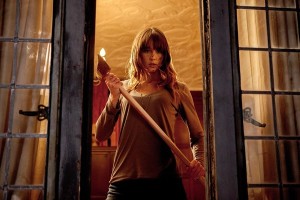 sensational in their approach, proudly announcing their arrival with titles like Surf Nazi’s Must Die (1987), Chopper Chicks in Zombie Town (1989), The Slumber Party Massacre (1982), and Voodoo Academy (2000). But whatever course they take, all of the B’s have one thing in common: little money but lots of audacity.
sensational in their approach, proudly announcing their arrival with titles like Surf Nazi’s Must Die (1987), Chopper Chicks in Zombie Town (1989), The Slumber Party Massacre (1982), and Voodoo Academy (2000). But whatever course they take, all of the B’s have one thing in common: little money but lots of audacity.
The average cost of a movie today is in the $60-$100 Million range and the blockbusters can cost a lot more. That’s just to make the movie – and doesn’t include the millions spent on advertising. So the range for a B-movie would be from whatever you and your friends can scrape together to about $5-10M. But budget alone doesn’t equate to B-movie status. Lost in Translation (2003, $4 Million), Juno (2007, $7.5 Million), Moon (2009, $5 Million), and Ghost World (2001, $7 Million) aren’t B-movies. And neither are Donnie Darko (2001) or Requiem for a Dream (2000), both with reported budgets of $4.5 Million.
The movies on this list have something more than just low budgets; they have that B-movie attitude, which is hard to describe but easy to recognize. It’s something that is lost when a film has too much money or too many stars. It’s lost in films like Reign of Fire (2002),  Terminator 3 (2003), The Core (2003), and Abraham Lincoln: Vampire Hunter (2012) – all B-movies at heart that suffer from the excesses of their budgets.
Terminator 3 (2003), The Core (2003), and Abraham Lincoln: Vampire Hunter (2012) – all B-movies at heart that suffer from the excesses of their budgets.
All of the films on this list have had a theatrical release, however brief (sorry Sharknado [2013]). The lowest (reported) budget on the list is seven thousand dollars and the most expensive came in at a whopping $8.5 Million, most of that for the very good CGI. But none of these movies could have been made any better with more money. Could James Cameron have improved Hobo with a Shotgun (2011)? I think not.
So here they are, in order of release date, the Best B-Movies of the 21st Century (so far).
[divider]
The Lost Skull of Cadavra (2001)
Budget: $40,000
 A spoof on the most spoof-worthy films of the 20th century: 1950s Science Fiction. It has that Mystery Science Theater 3000 feel – and I mean that in a good way – so if nothing else, you can do your own commentary. A good scientist and his oh-so-1950s wife, a very bad scientist, and alien visitors all seek that rarest of elements: atmospherium. Everybody overplays their parts just enough, the script is downright silly, and the film succeeds in being genuinely cheesy and in capturing how great bad movies can be.
A spoof on the most spoof-worthy films of the 20th century: 1950s Science Fiction. It has that Mystery Science Theater 3000 feel – and I mean that in a good way – so if nothing else, you can do your own commentary. A good scientist and his oh-so-1950s wife, a very bad scientist, and alien visitors all seek that rarest of elements: atmospherium. Everybody overplays their parts just enough, the script is downright silly, and the film succeeds in being genuinely cheesy and in capturing how great bad movies can be.
May (2002)
Budget: $500,000
 A little girl with a lazy eye who is laughed at and ostracized by her schoolmates grows into a very weird, yet oddly attractive, young woman. She lives alone, sews her own clothes and works in a veterinarian’s office where her skill with a needle and thread are applied in assisting the vet in surgery. She wants a boyfriend but her limited social skills aren’t helping. So she comes up with a very creative, and horrifying, solution. May is a very sympathetic character in the first half of the film and the films progression from a dark comedy to another kind of darkness is compelling. The film is not just disturbing, it’s very moving and Angela Bettis gives an incredible performance in the title role.
A little girl with a lazy eye who is laughed at and ostracized by her schoolmates grows into a very weird, yet oddly attractive, young woman. She lives alone, sews her own clothes and works in a veterinarian’s office where her skill with a needle and thread are applied in assisting the vet in surgery. She wants a boyfriend but her limited social skills aren’t helping. So she comes up with a very creative, and horrifying, solution. May is a very sympathetic character in the first half of the film and the films progression from a dark comedy to another kind of darkness is compelling. The film is not just disturbing, it’s very moving and Angela Bettis gives an incredible performance in the title role.
Primer (2004)
Budget: $7,000
 After showing the film at a few festivals, the director secured the additional $30,000 required to make a usable print. Filmed in garages, storage lockers, apartments, by the side of the highway, and anywhere else they could set up without getting run off, this is a movie that has ideas much bigger than its budget. A couple of guys trying to start a tech company out of a garage make a startling discovery – they have invented a time machine. But they can only travel back in time and only a few days which means rule number one is you have to avoid yourself. This one gets a little talky and a bit hard to follow so it will help if you’re well versed in the rules of time travel.
After showing the film at a few festivals, the director secured the additional $30,000 required to make a usable print. Filmed in garages, storage lockers, apartments, by the side of the highway, and anywhere else they could set up without getting run off, this is a movie that has ideas much bigger than its budget. A couple of guys trying to start a tech company out of a garage make a startling discovery – they have invented a time machine. But they can only travel back in time and only a few days which means rule number one is you have to avoid yourself. This one gets a little talky and a bit hard to follow so it will help if you’re well versed in the rules of time travel.
Behind the Mask: The Rise of Leslie Vernon (2006)
Budget: Very low and unreported
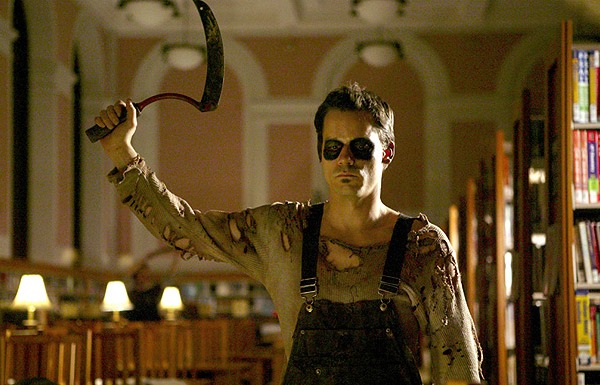 Leslie Vernon is a small town boy who aspires to the greatness of Jason Vorhees, Freddy Kruger, and Michael Myers. A documentary filmmaker hoping for her breakthrough, records his bizarre view of the world and the people and events that have shaped his destiny. As Leslie takes her through the preparations that will lead to his first kill, she comes to realize that this is really going to happen. The horrified crew tries to stop it, but it’s too late. The film shows a great sense of humor through the first two acts before it turns into a slasher movie going from a documentary hand-held camera style to some conventionally filmed scenes in the process.
Leslie Vernon is a small town boy who aspires to the greatness of Jason Vorhees, Freddy Kruger, and Michael Myers. A documentary filmmaker hoping for her breakthrough, records his bizarre view of the world and the people and events that have shaped his destiny. As Leslie takes her through the preparations that will lead to his first kill, she comes to realize that this is really going to happen. The horrified crew tries to stop it, but it’s too late. The film shows a great sense of humor through the first two acts before it turns into a slasher movie going from a documentary hand-held camera style to some conventionally filmed scenes in the process.
Once (2007)
Budget: $200,000
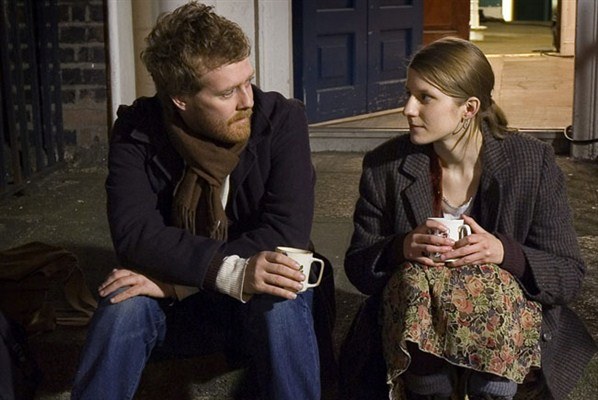 In Dublin, Ireland, a street musician meets a young Czech immigrant and with his acoustic guitar and any borrowed piano they can find for her to play, they make incredible music. As their music intensifies so does their friendship, but she has a husband back in Czech Republic and he a fiancé in London, and their feelings for each other add even more pathos to a very moving story. The two leads are played by musicians Glen Hansard and Markéta Irglová who wrote and performed all the songs and their acting, along with the realism of the directing, cinematography, lighting, sound, and editing, give this film an honesty that few have. It’s worth watching for the music alone – the film was awarded an Oscar for best song. This is great example of a film Hollywood would have only ruined.
In Dublin, Ireland, a street musician meets a young Czech immigrant and with his acoustic guitar and any borrowed piano they can find for her to play, they make incredible music. As their music intensifies so does their friendship, but she has a husband back in Czech Republic and he a fiancé in London, and their feelings for each other add even more pathos to a very moving story. The two leads are played by musicians Glen Hansard and Markéta Irglová who wrote and performed all the songs and their acting, along with the realism of the directing, cinematography, lighting, sound, and editing, give this film an honesty that few have. It’s worth watching for the music alone – the film was awarded an Oscar for best song. This is great example of a film Hollywood would have only ruined.
Chocolate (2008)
Budget: $4.8 Million
 An autistic child of a Japanese Yakuza and the gun moll of a Thai gangster learns while watching martial arts movies. When she grows up she uses her skills to collect old debts owed to her ostracized mother who is kept in poverty under orders from the Thai godfather as punishment for betraying him. As with most martial arts films the set piece fight scenes are the attraction, but this one does have a good story with well-acted, sympathetic characters. The final act is a reprise of Beatrice Kiddo vs. The Crazy 88s, but the choreography is a bit more realistic and the fighting much more real. The performers spent two years in training and another two years making the film – a schedule which was required in order to allow them to heal from their injuries (you’ll want to watch the DVD extras).
An autistic child of a Japanese Yakuza and the gun moll of a Thai gangster learns while watching martial arts movies. When she grows up she uses her skills to collect old debts owed to her ostracized mother who is kept in poverty under orders from the Thai godfather as punishment for betraying him. As with most martial arts films the set piece fight scenes are the attraction, but this one does have a good story with well-acted, sympathetic characters. The final act is a reprise of Beatrice Kiddo vs. The Crazy 88s, but the choreography is a bit more realistic and the fighting much more real. The performers spent two years in training and another two years making the film – a schedule which was required in order to allow them to heal from their injuries (you’ll want to watch the DVD extras).
Dark and Stormy Night (2009)
Budget: $1 Million
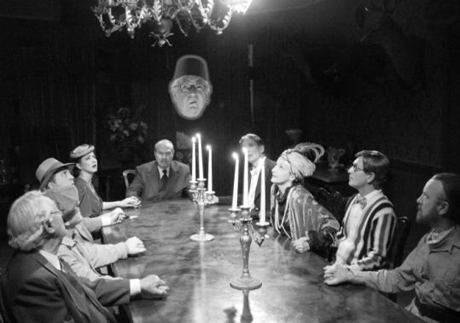 A haunted house parody set in the 1930s that definitely overcomes its self-awareness. It manages to not cross the line into trying too hard, the actors smoothly deliver dialogue that runs from the banal to the brilliant, and the black and white photography is perfect for the setting. The family of a recently deceased wealthy patriarch gather at the old mansion for the reading of the will where they are bumped off one at a time in the style of an Agatha Christie mystery novel. All of the actors are very good as is the script, and the set bound film has the feel of a stage play – and a good one.
A haunted house parody set in the 1930s that definitely overcomes its self-awareness. It manages to not cross the line into trying too hard, the actors smoothly deliver dialogue that runs from the banal to the brilliant, and the black and white photography is perfect for the setting. The family of a recently deceased wealthy patriarch gather at the old mansion for the reading of the will where they are bumped off one at a time in the style of an Agatha Christie mystery novel. All of the actors are very good as is the script, and the set bound film has the feel of a stage play – and a good one.
Tucker and Dale vs. Evil (2010)
Budget: $5 Million
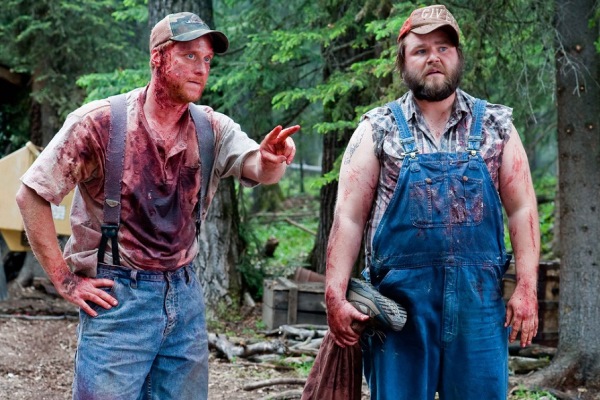 Thanks to John Boorman’s Deliverance (1972), we all have a pretty good idea of what happens when city slickers get lost in the wilds of the South. When two locals, nice guys Tucker and Dale, have an encounter with a group of college kids they are mistaken for a couple of backwoods psycho killers. When they rescue one of the girls who has injured herself and take her back to their cabin, her friends sharpen their sticks and set out to save her. The misunderstandings become the expected comedy of errors but when it morphs into a slasher film the real fun begins. Not an easy thing to make the slasher scenes gruesome and funny at the same time, but this one pulls it off.
Thanks to John Boorman’s Deliverance (1972), we all have a pretty good idea of what happens when city slickers get lost in the wilds of the South. When two locals, nice guys Tucker and Dale, have an encounter with a group of college kids they are mistaken for a couple of backwoods psycho killers. When they rescue one of the girls who has injured herself and take her back to their cabin, her friends sharpen their sticks and set out to save her. The misunderstandings become the expected comedy of errors but when it morphs into a slasher film the real fun begins. Not an easy thing to make the slasher scenes gruesome and funny at the same time, but this one pulls it off.
Monsters (2010)
Budget: $800,000
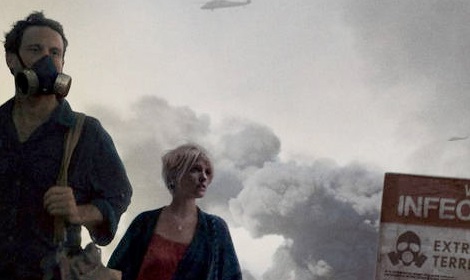 After discovering alien life, a returning NASA probe crashes in Central America. Soon alien monsters appear and Mexico becomes a war zone. Our story starts six years later when a journalist covering the events agrees to help a young American woman get back to the United States. The two make the dangerous trip by train, bus and on foot led by paid guides with uncertain motives. They are under threat from the aliens at all times, but with a budget like this the producers didn’t have enough money for too many monster scenes so their trip through a Mexico under siege is really more of a life during wartime story. The final scene, an encounter with the aliens at the US border, explains the meaning of the opening scene and gives the film a great ending.
After discovering alien life, a returning NASA probe crashes in Central America. Soon alien monsters appear and Mexico becomes a war zone. Our story starts six years later when a journalist covering the events agrees to help a young American woman get back to the United States. The two make the dangerous trip by train, bus and on foot led by paid guides with uncertain motives. They are under threat from the aliens at all times, but with a budget like this the producers didn’t have enough money for too many monster scenes so their trip through a Mexico under siege is really more of a life during wartime story. The final scene, an encounter with the aliens at the US border, explains the meaning of the opening scene and gives the film a great ending.
Iron Sky (2012)
Budget: $8.5 Million
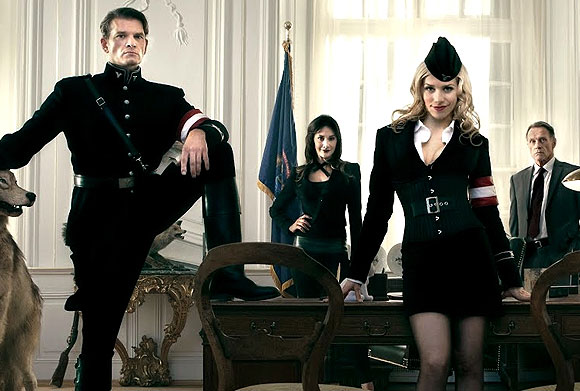 After their defeat in WWII the Nazis repair to the dark side of the moon where they plan their triumphant return. They haven’t changed much as they wear leather trench coats, drive Daimlers, and click their heels as they produce the next generations of Aryans who will oversee their triumphant return to Earth. In 2018 they launch “meteor blitzkrieg,” an armada of oversized zeppelins and flying saucers. The US President – a Sarah Palin knockoff – warms to the task as she needs a good war for her re-election campaign. The idea is brilliant and I couldn’t help but feel that they should have done more with it – a few more mädchens in uniform would have helped – but it’s still lots of fun. No matter, this one had me at Nazis.
After their defeat in WWII the Nazis repair to the dark side of the moon where they plan their triumphant return. They haven’t changed much as they wear leather trench coats, drive Daimlers, and click their heels as they produce the next generations of Aryans who will oversee their triumphant return to Earth. In 2018 they launch “meteor blitzkrieg,” an armada of oversized zeppelins and flying saucers. The US President – a Sarah Palin knockoff – warms to the task as she needs a good war for her re-election campaign. The idea is brilliant and I couldn’t help but feel that they should have done more with it – a few more mädchens in uniform would have helped – but it’s still lots of fun. No matter, this one had me at Nazis.
Big Ass Spider (2013)
Budget: $500,000
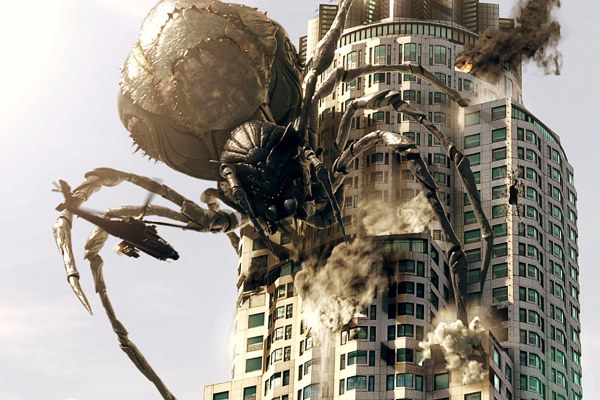 Another movie that asks you to forgive it for not having enough money for the special effects required to make a suitable title character – a very large spider. A bug exterminator – don’t worry, he specializes in spiders – and a security cop team up to save the day as Los Angeles is attacked by a mutant arachnid that comes out of a casket in the city morgue. Assisting our heroes is the, as always, overly eager US Army led by the properly square jawed Major Braxton Tanner. Don’t let the title fool you; well written, acted, and directed, this is a very entertaining science fiction comedy and not to be confused with those bad Science Fiction Channel movies with equally silly titles (this is the exception).
Another movie that asks you to forgive it for not having enough money for the special effects required to make a suitable title character – a very large spider. A bug exterminator – don’t worry, he specializes in spiders – and a security cop team up to save the day as Los Angeles is attacked by a mutant arachnid that comes out of a casket in the city morgue. Assisting our heroes is the, as always, overly eager US Army led by the properly square jawed Major Braxton Tanner. Don’t let the title fool you; well written, acted, and directed, this is a very entertaining science fiction comedy and not to be confused with those bad Science Fiction Channel movies with equally silly titles (this is the exception).





